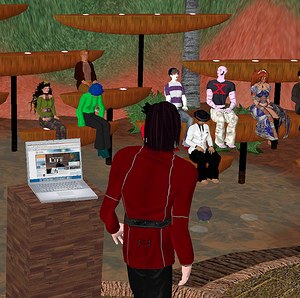 |
|
“iPad” Flickr photo by Jeff Henshaw ((Henshaw, Jeff. “iPad.” Jeff Henshaw’s Photostream. N.p., 7 Apr 2010. Web. 7 Apr 2010. |
Not quite. I spent about fifteen minutes with an Apple iPad yesterday, after watching about fifteen other people dominate the display devices — all of them playing the same racing game, driving their devices like steering wheels. I don’t get that — but it’s OK.
I was mostly impressed and I have to disagree with claims that it’s just a big iPod Touch. It’s more than that, even if only a little bit more. ..And don’t knock the bigger screen. It’s a major part of the machine’s appeal.
But even though it was such a compelling experience that I feel a little funny calling it a machine, I walked out of the Apple Store without an iPad. I suspect I’ll ultimately get one, but not quite yet.
Even though I,
- Celebrate the growing move toward personal digital devices for all learners,
- Recognize the tremendous (and entirely avoidable) budget constraints schools are facing,
- Agree that pocket tech is an information avenue of choice for ‘natives,’ and
- Am even impressed by some of the very clever applications that have appeared,
I still have concerns — even though the iPad resembles, remarkable, the learner device I described in the first edition of Redefining Literacy.
Yesterday, Laura Sydel reported on NPR that the iPad may change the way that we do Internet, quoting Paul Sweeting, analyst for GigaOM, “With the iPad, you have the anti-Internet in your hands.” His seemingly urgent concern was of a device that, while seductively appealing, is designed to deliver content, media, and entertainment (approved by Apple Inc.) to eager information consumers. Might we forget that one of the foundational qualities of the Internet is that it reflects us, not Apple.
Calming things down a bit, a sidebar was later added to the web-based version of NPR piece, stating:
Actually Sweeting isn’t worried about anything. “I was simply offering observations (and by the way, you will be able to access pornography on the iPad thanks to Apple’s new relaxed content policy). I think the iPad will have a lot of appeal to a lot of people. I was trying to be clear about what they’re getting.” –Paul Sweeting (themediawonk) ((Sydell, Laura. “Apple’s iPad: The End Of The Internet As We Know It?.” NPR 5 Apr 2010: n. pag. Web. 6 Apr 2010. <http://www.npr.org/templates/story/story.php?storyId=125561844>.))
I mentioned the article to Brenda at lunch yesterday and the concern that people will spend more time watching their computers and much less time, effort, and creativity producing reflective blogs, videos, podcasts, digital art, etc. She said, “Well people will still use laptops and desktops.”
I have to ask, “Will they?”
Has Apple built the perfect TV set? ABC and Netflix hope so. ((Lawler, Ryan. “Netflix, ABC to Release Apps for iPad Launch.” NewTeeVee. 1 Apr 2010. Web. 6 Apr 2010. <http://newteevee.com/2010/04/01/netflix-abc-to-release-ipad-apps-for-launch/>.))
 |
|
Somewhat counter to my position is this Flickr photo by Shrryn Marrow ((Marrow, Sharyn. “iPad Keyboard.” MassDistraction’s Photostream. N.p., 5 Apr 2010. Web. 7 Apr 2010. |
Certainly Apple’s aim is not to kill the Internet as we know it. Their job is to design a product that we will want to buy and use. How it is used will be up to us. My worry is that budget conscious (traumatized) school administrators will see the iPad as an easy (easier) way to achieve the new dream of 1:1, and tech leaders, with the best intentions, will leap at the chance to be current in educational tech — even if for only a few months.
…and this is fine.
I have no real problem with every learner walking into the class room with a digital tablet under their arm — as long as students also have access to the workhorses they will need to seriously crunch numbers, generate data visualizations, produce compelling video messages, do serious writing, compose music, and craft digital art.
As we usher in the personal learning device, we have to say, “This is not all you’re going to need.“


